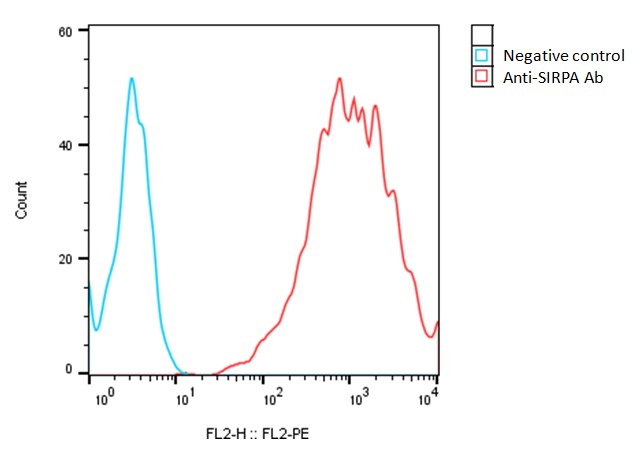
| Catalog Number | Product | Size | Price | |
|---|---|---|---|---|
| C3065 | Human SIRPA-CHO-K1 Stable Cell Line | 2 vials | $3950 | Order |
| Catalog Number | C3065 |
|---|---|
| Cell Line Name | Human SIRPA-CHO-K1 Stable Cell Line |
| Accession Number | XP_054179022.1 |
| Host Cell | Adherent CHO-K1 |
| Quantity | Two vials of frozen cells (2x106 per vial) |
| Culture Medium | DMEM with 10% FBS, 4 µg/ml puromycin |
| Freezing Medium | 90% FBS and 10% DMSO |
| Storage | Liquid nitrogen upon receipt |
| Product Datasheet: | Download PDF |
Detection of human SIRPA expression on human SIRPA-CHO-K1 stable cells using a monoclonal antibody specific for human SIRPA (BioLegand, #323805)

Signal Regulatory Protein Alpha (SIRPA), also known as SHPS-1 (Src homology 2 domain-containing protein tyrosine phosphatase substrate-1), is a transmembrane receptor protein that plays a pivotal role in regulating immune responses, cell adhesion, and signal transduction. SIRPA serves as an immune checkpoint molecule that is predominantly expressed on the surface of myeloid cells, such as macrophages and dendritic cells. It interacts with its ligand, CD47 to modulate phagocytosis by transmitting inhibitory signals to macrophages, preventing them from engulfing and destroying cells displaying CD47. SIRPA’s extracellular domain interacts with extracellular matrix proteins contributing to cell adhesion, migration, and tissue integrity. SIRPA's cytoplasmic domain contains immunoreceptor tyrosine-based inhibitory motifs (ITIMs) that, when phosphorylated, leads to downstream inhibitory signaling modulating immune responses and cell adhesion. Many cancer cells upregulate the expression of CD47 to evade immune surveillance. Consequently, the SIRPA-CD47 interaction contributes to immune escape by inhibiting phagocytosis of cancer cells. Overexpression of SIRPA is also observed in some cancer types, further implicating its role in cancer progression. Various strategies are being explored to modulate the SIRPA-CD47 interaction to block this inhibitory pathway and aim to enhance the immune system's ability to recognize and eliminate cancer cells.
Barclay AN, Van den Berg TK. (2014) "The interaction between signal regulatory protein alpha (SIRPA) and CD47: structure, function, and therapeutic target." Annu Rev Immunol. 32:25-50.
Murata, Yoji et al. “CD47-signal regulatory protein alpha signaling system and its application to cancer immunotherapy.” Cancer science. 8: 2349-2357. 2018.
Willingham SB, et al. (2012) "The CD47-signal regulatory protein alpha (SIRPA) interaction is a therapeutic target for human solid tumors." Proc Natl Acad Sci U S A. 109(17):6662-7.